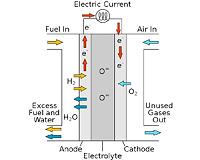 |
Anaheim CA (SPX) Apr 04, 2011 The next-generation battery, like next-generation TV, may be 3-D, scientists reported at the 241st National Meeting and Exposition of the American Chemical Society (ACS). They described a new lithium-ion (Li-ion) battery, already available in a prototype version, with a three-dimensional interior architecture that could be perfect for the electric cars now appearing in auto dealer showrooms. The 3-D Li-ion battery recharges in minutes, rather than hours, and could bring closer the day in which electric cars can recharge as quickly as gas-powered vehicles "fill it up" at the pump. The 3-D format could be the basis for more powerful, longer-lasting batteries for scores of other rechargeable electronic devices, scientists said. Study leader Amy Prieto, Ph.D., said the research team has a 3-D prototype, about the size of a cell phone battery, that takes about 12 minutes to recharge compared to two hours for a conventional lithium-ion battery. The battery also can be discharged over twice as many times as a conventional lithium ion battery at high discharge rates, she added. "The time needed to recharge cell phones, laptops and other electronics products certainly can be an occasional nuisance," Prieto noted. "However, it certainly doesn't keep anyone from buying these products. Recharge time may be a much more important factor for electric cars. You make a rest stop on the turnpike, and you want to recharge quickly, just like you fill-it-up at the gas pump. It's going to take a new generation of batteries to do so, and we hope our 3-D battery is poised to be at the forefront. If our battery works to its potential, it could be the ideal battery for an electric car." Prieto's research at Colorado State University in Fort Collins, Colo., is part of a larger scientific quest to improve Li-ion batteries, which already outperform their nickel-cadmium (NiCad) cousins in many ways. Li-ion batteries, for instance, pack twice as much energy per ounce as NiCads; their high cell voltage of 3.6 volts allows battery pack designs with only one cell, and there is no "memory effect" that limits a Li-ion's ability to fully recharge. Their solution involves a fundamental change in the battery's interior. Conventional Li-ions are composed of graphite, a form of carbon that serves as the anode (negative electrode), a lithium compound that serves as the cathode (positive electrode), and an electrolyte that separates the electrodes. The electrodes are arranged in multiple, thin layers, like a stack of pancakes. Lithium ions (electrically charged particles of lithium) move from the carbon anode through the electrolyte to the lithium cathode during discharge and back when recharging. However, that configuration accounts for the Li-ion's major disadvantages: They tend to recharge slowly, have a limited life (about two years), and require special built-in circuits to prevent overheating. Preito's team did some reconfiguring in an attempt solve these problems. They replaced the graphite anode with nanowires of copper antimonide, a metallic material composed of copper and antimony. The nanowires, each barely 1/50,000th the width of a single human hair, have an enormous surface area and can store twice as many lithium ions as the same amount of graphite per unit volume. The nanowires also are more chemically stable than graphite and also more heat resistant. Their prototype 3-D battery is about the size of a cell phone battery. Inside the battery, they arranged the nanowires into a tightly-packed, three-dimensional structure resembling the bristles of a hair brush. For the final configuration, the nanowires will be coated with a thin layer of electrolyte - the material the separates the anode from the cathode - and surrounded with conventional cathode material made of lithium. Laboratory tests showed that the first prototype (which is not interdigitated yet) could recharge in as little as 12 minutes compared to two hours for a standard lithium-ion phone battery. Prieto said the battery should have a life span over double that of existing lithium ion batteries. Commercial versions of the battery would be thinner and lighter than equivalent Li-ion batteries, because the 3-D version holds more lithium per unit volume. Prieto has co-founded her own company, Prieto Battery, to commercialize the technology and says that the first 3-D batteries could be available to consumers in as little as two years. The scientists acknowledge funding from the National Science Foundation and private donors.
Share This Article With Planet Earth
Related Links American Chemical Society Powering The World in the 21st Century at Energy-Daily.com
 TU Delft Identifies Huge Potential Of Nanocrystals In Fuel Cells
TU Delft Identifies Huge Potential Of Nanocrystals In Fuel CellsDelft, Germany (SPX) Mar 29, 2011 The addition of extremely small crystals to solid electrolyte material has the potential to considerably raise the efficiency of fuel cells. Researchers at TU Delft were the first to document this accurately. Their second article on the subject in a very short time was published in the scientific journal, Advanced Functional Materials. The researchers at the Faculty of Applied Sciences at ... read more |
|
| The content herein, unless otherwise known to be public domain, are Copyright 1995-2010 - SpaceDaily. AFP and UPI Wire Stories are copyright Agence France-Presse and United Press International. ESA Portal Reports are copyright European Space Agency. All NASA sourced material is public domain. Additional copyrights may apply in whole or part to other bona fide parties. Advertising does not imply endorsement,agreement or approval of any opinions, statements or information provided by SpaceDaily on any Web page published or hosted by SpaceDaily. Privacy Statement |